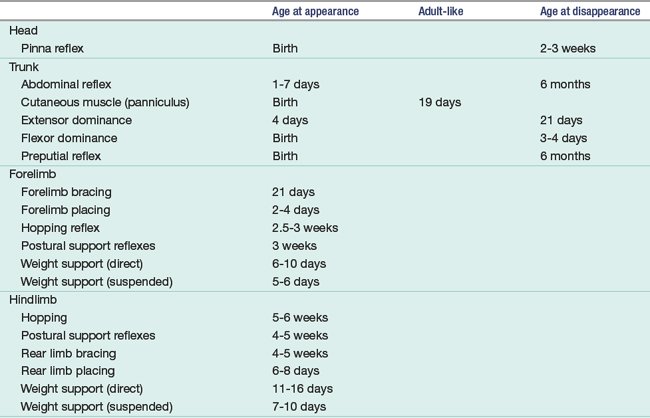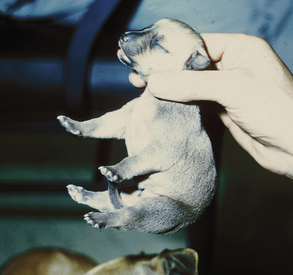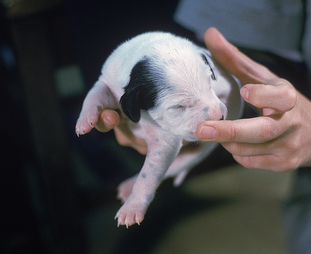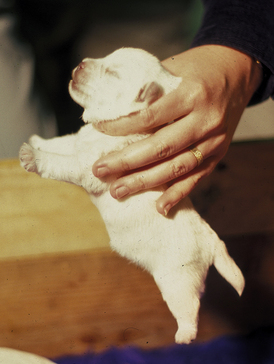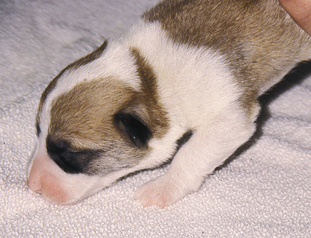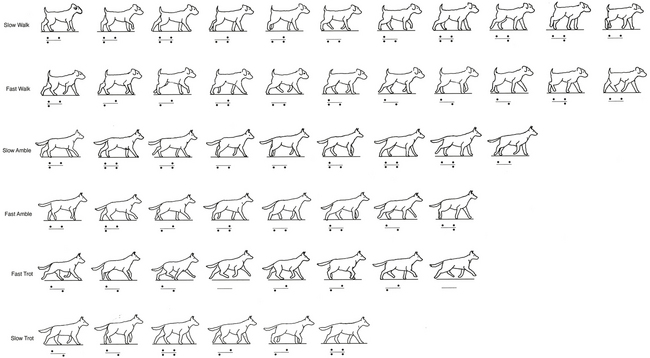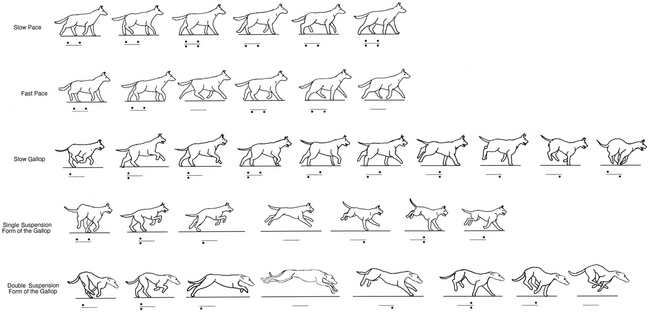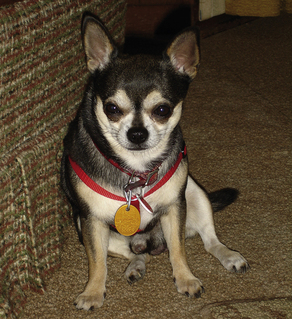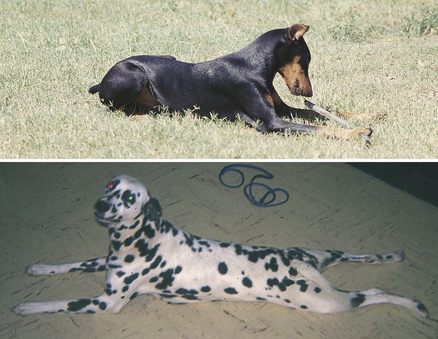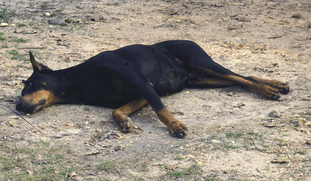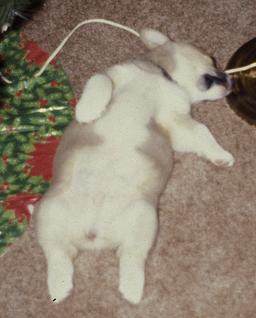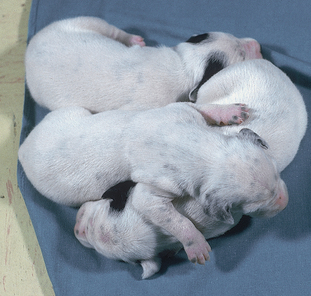CHAPTER 9 Canine Locomotive Behavior
INFANT GROWTH AND MOVEMENTS
Prewalking Movements
Because of its immature state of development at the time of birth, a puppy depends on a number of different reflexes for protection. Those involving sensory perception were discussed in Chapter 2 and summarized in Table 2-1. Those for locomotor skills, plus or minus sensory input, are summarized in Table 9-1. A new puppy moves with circular and side-to-side movements. While doing so, it uses its head in side-to-side scanning-like motions and as a lever against anything rigid enough to push against.22,27,72,94 The front limbs make awkward paddling-like movements, while the rear limbs make right-left pushing attempts.72
Several motor reflexes are present at or near birth. Some persist into adulthood; others decrease over time. If a newborn puppy is gently suspended by its neck, the back flexes, and the puppy curls up (Fig. 9-1). This excess of the vertebral flexor response is present from birth to day 4 and is called flexor dominance.57,59,60,96,105 If the head is extended dorsally, the forelimbs extend, and the rear ones flex; if the neck is flexed, the rear limbs extend.27
The pinna reflex is present from birth until 2 to 3 weeks of age.11,56 To demonstrate this reflex, hold the puppy so that its vertebral column is parallel to the floor and dorsal relative to the rest of the puppy. The long axis of the body is rotated 90 degrees. As soon as the tilting of the head begins, the upper pinna will rise dorsally away from the body until its external surface falls toward the top of the puppy’s head and the external auditory canal is exposed. The lower pinna will point toward the ground.11,55,56
The abdominal reflex is present in 80% of young puppies but only 1% of adults.56 Stroking of the abdomen results in a contraction of the abdominal muscles. This reflex tends to disappear around 6 months of age.56 In 94% of male puppies, the preputial reflex results in the penis being withdrawn when the puppy is stroked cranial to the prepuce. This reflex remains in 30% of adult dogs.56 The cutaneous muscle (panniculus), scratch, and superficial anal reflexes are present in 94% to 100% of all dogs regardless of age, although they may strengthen as the dog gets older.56,57 The Magnus reflex is another reflex present from birth, and it lasts approximately 21 days.57,60,105 When the head is turned to one side, the fore and rear limbs on the side toward which the head is turned will extend, and the opposite limbs will flex (Fig. 9-2).27,60
The placing responses also appear in very young puppies. When a forelimb touches an edge, a puppy will begin placing it on top of the edge at 2 to 4 days of age.57,59,60 The capability to support weight, and thus walk, comes later. Around 4 days of age, the dominance of the vertebral flexors is rather quickly replaced by extensor dominance (Fig. 9-3). In this typically quick transition, the vertebral extensors overpower the flexors when the puppy is gently suspended by its neck. The resulting arched-back response will continue until the puppy is almost 21 days old.60,96,105
The seal reflex is somewhat similar, but it starts around 2 weeks of age and gradually disappears. If the puppy is held vertically by grasping it just caudal to the forelimbs, it becomes opisthotonic, with the hind limbs extended caudally, the toes spread, and the neck extended.11,27 If the puppy is held vertically, with the head down instead of up, a slight opisthotonos will also occur, called a supporting reaction.55 In another supporting reaction, puppies placed on a 25-degree incline have a strong tendency to orient upward. They will squirm and use distress vocalizations if pointed downward, whereas they will sleep if pointed upward. As soon as they are physically strong enough, as early as 4 days, they will pull themselves around.95 By day 25, a puppy can actually rotate its body a full 180 degrees by pivoting on its rear end.95
Walking and Other Later Movements
The initial movements a puppy makes are paddling-like, and they make little forward progress. Support of body weight on the forelimbs does not begin until 7 to 14 days of age,59,60,96 with heavier puppies taking longer (Fig. 9-4). A puppy can move backward once it can hold its forelimbs under its body, even though weight support may not be possible yet.94 This ability to back away appears about day 12, although it may take up to 5 days later than that for surfaces that are not flat.55,94,95 Rear limb support begins at 14 or more days,57,59,60,94 and standing occurs by 21 days.57,59 Initially, walking is very unsteady, but by 21 days, puppies are quite mobile and move well in a straight line.55,94,96
Bracing itself when pushed is another type of postural support that a puppy develops over time. A puppy will brace or show lateral stepping with the forelimbs at approximately 3 weeks of age.27 In the rear, the ability for this type of support begins at 4 to 5 weeks.27 From then on, motor skills rapidly mature; and, with the parallel sensory development, puppies can orient on distant littermates and objects.65 Puppies that stay with their mother until they are 6 to 10 weeks old are influenced by her and have significantly better developed motor ability and agility than those that are separated from her at 6 weeks.51
Once the puppy is capable of moving and is old enough to go to its new home, puppy behaviors can become potential problems. When left alone, puppies that are acquired from private sources, not from dog breeders, show more exploratory behavior, but the actual amount is affected by its age.36
ADULT MOVEMENTS
Studies of adult, laboratory-raised dogs show several types of activity patterns. This is divided into 2.9 hours of movement, 4.3 hours of wakeful resting, and 3.7 hours in transitional behaviors.146 They may sleep for the remaining 13 hours. Those housed in outdoor kennels show significantly higher activity levels, increased frequency of moving, and lower frequency of passive behavior.134
Dog owners describe their adult pets as being very (48%) to moderately (46%) active,132 and studies have shown that the actual number of steps taken does correlate with the owner’s perception.37 It also correlates to the activity of their owners.37 The average owner takes the dog on a leash walk or jog between three and seven times a week for exercise.132 The dog is exercised off leash about as often, with 84% of the dogs doing some or a lot of running during this free time.132 Overall activity levels in dogs are quite variable,43 probably because much of a dog’s movement tends to be reactive rather than spontaneous.45 This was collaborated in laboratory dogs, regardless of cage size.31
Activity levels in giant breed dogs have been linked to health in an interesting way. Giant dogs with high activity levels and a “high level of happiness” are at a reduced risk for gastric dilation-volvulus.69 This correlation does not hold true for large-breed dogs.
Aging can result in a greater decline in curiosity, exploration, and responses to novel stimuli than to activity.131 Even after consideration of degenerative orthopedic conditions, though, activity levels in older dogs tend to be reduced.91,131 Old dogs spend more time awake and in slow-wave sleep and less time in rapid eye movement (REM) sleep than do young adult dogs.135 It has been observed in racing sled dogs that activity levels are diurnal, tending to increase around sunrise and sunset, and are independent of ambient temperatures.45
Walking
The walk of a dog is a four-beat gait in which each foot touches the ground at a different time (Fig. 9-5). Each hind foot is placed less than one quarter of a cycle before the forelimb on the same side.93 In the walk, there are typically two or three feet on the ground at anyone time. Three feet on the ground at one time is the most common and at no time are there less than two on the ground.8 In a really slow walk, all four feet may touch the ground at a time but briefly. The gait is described as symmetric because the movements during the second half of a complete stride are a mirror image of those during the first half. The actual footfall pattern remains the same for all dogs. The timing of each foot striking the ground is relative to that of another specific foot, and it varies among dogs and at different speeds.
The vertical force exerted on the pads of the front feet of a walking dog is approximately equal to the dog’s body weight.92 It is less on the rear limb pads, approximating 0.8 of the body weight.92 Ground contact time for the front pads is about 1.5 times longer than for the rear limbs.92
Ambling
The amble, also called the slow pace or the running walk, is also a four-beat, symmetric gait that has the same footfall pattern as the walk (see Fig. 9-5). The difference between the amble and the walk is a visual one. In the amble, the limbs on each side of the body appear to be moving forward at almost the same time, with the rear limb touching the ground slightly before the front limb touches it. The slower version includes a segment in which all four limbs have ground contact at the same time.
Trotting
The trot is a two-beat, symmetric gait (see Fig. 9-5). The contralateral fore and hind feet move forward in unison, landing at the same time. Usually a suspension phase exists between the lifting of one alternate pair of limbs and the landing of the next pair. In a very slow trot, there will be a very short period in which all four limbs are in contact with the ground instead of being suspended above it.
The trot is probably the most popular gait for dogs. It allows them to cover a lot of ground quickly, but it does not use much energy. The stride frequencies at preferred trotting speeds are approximately 0.85 those of the galloping frequency.10 As the diaphragm moves forward and backward twice during each full stride cycle, the frequency of breathing during trotting is 1.7 times that during galloping.10 When a forepaw is on the ground, the thorax on that side is also compressed, so that between diaphragmatic action and thoracic compression, ventilation during the trot can be regarded as asynchronous.10,25
Pacing
The pace is another two-beat, symmetric gait (see Fig. 9-5). Here the limbs on the same side of the body move forward in unison. Because the body’s center of gravity shifts from right to left and back, the dog has a sideways rocking motion. All four feet make ground contact at the slowest expression of the pace. The most typical faster pace has a suspension phase. Dogs that pace tend to have a slightly elevated center of gravity as they perform this gait. They also tend to have a short back-relative-to-leg length. As a result of this conformation, they may have learned to modify their trot into a pace to avoid interference between feet on the same side.
Galloping/Running
The gallop is the fastest of the dog’s gaits, being a four-beat and asymmetric movement. During the slowest form of the gallop, the canter, between one and three feet maintain ground contact (see Fig. 9-5). As the dog goes faster, the canter changes to the single-suspension form of the gallop. Here the vertebral column is extended and the body is suspended in the air (“floating phase”93) between the time the rear limbs push off and the forelimbs touch down again.66 The fastest gallop is the double-suspension version, with a second suspension phase occurring as the forelimbs leave the ground. There is enough forward push to lift the body off the ground for a brief period before the rear limbs touch down. The total amount of time a dog is suspended approximates one third of the total time for one complete stride.83 This phase of second suspension is possible only because of a very flexible vertebral column that allows the rear limbs to overreach and land in front of the spot where the front feet were.66 Using a double suspension, a racing Greyhound can achieve speeds approximating 40 miles per hour.78
At all speeds of the gallop, a careful observer can notice that one forelimb and one rear limb land before the contralateral limb. The second limb of the pair is then placed slightly forward from the first. If the second foot to land of the front and rear pairs is the left foot, the dog is said to have a “left lead” in front and behind. Dogs often switch their lead foot as they run. They will commonly cross-canter (also called a “rotatory gallop”93) by using the opposite lead in the front from that in the rear. The relative lateral rigidity of horses makes it important for them to use an inside lead as they gallop around a corner. In other words, if a horse is galloping in a circle to its left, it is most stable if it is in the left-lead front and rear. Because most dogs are very flexible and have a low center of gravity, leads are less important for them from a safety standpoint.
Breathing during the gallop is at a ratio of one breath to one stride.24 The aerobic work capacity of the diaphragm averages 23% and is constant as the workload increases.124 Only when the phrenic venous oxygen tension gets below a certain point do problems occur.124
Jumping
In dogs, jumping tends to take two forms. In the first, the dog springs straight up into the air from a push by both rear limbs. This dog might be trying to see out the window, reach a doorknob, or grab a tasty morsel off a counter. As the dog leaves the ground, the forelimbs are accelerated against thebody, and the center of gravity shifts.140 During the floating phase, there is no activity in the muscles of the rear limbs,140 but they absorb the shock as the dog lands on both rear limbs first. The second type of jumping is from one location to another across a space. Examples would include a dog jumping over a hurdle, across a mud hole, or onto a sofa. The dog pushes off with the rear limbs, either with both at the same time from a standing start, or with one slightly before the other if galloping. It lands on the front feet with one forelimb touching down first and slightly behind where the second will land.
Muscles, tendons, ligaments, and bones take a tremendous beating during jumping activities.9 That holds true regardless of whether the jump covers a long distance or a vertical height.
Paw Dominance
Many house dogs will use one foot to paw at their bedding as they rearrange it before lying down or to scratch at a door when asking to go out. Studies in paw dominance (also called “laterality”) are not always easy to set up in an objective way because of environmental and positional influences. Yet, paw dominance is a subject of much interest, especially to schoolchildren looking for science fair projects. Controlled studies have shown that approximately 57% of dogs show a preference for their right paw,136 and female dogs are more likely to show this right-paw preference.123 Another 18% show a left-paw preference, leaving 25% as ambidextrous.136 Of all dogs tested, 75% show a strong preference too, especially if it is in favor of the right paw.136
Paw dominance turns out to be slightly more complicated than left paw–right paw. Paw dominance, or factors relating to it, also affects immunity. Left-pawed individuals have a higher percentage and absolute number of lymphocytes.123 They also have a lower percentage of granulocytes and number of γ-globulins than either right-pawed or ambidextrous dogs.123 There is also a correlation between laterality of a dog and its response to immunization. Dogs that are left-pawed develop lower immunoglobulin G antibody titers and interferon-γ serum levels following a rabies vaccination than do right-pawed or ambidextrous dogs.122 The interleukin-10 responses do not differ.
Reaction to noise may also be related to paw dominance, or rather to the lack of it. There is a positive correlation between ambidextrous dogs and noise phobia.26
A study looking at brain anatomy and paw dominance concluded that there is no correlation between either cerebral asymmetry or fissures and a dominant paw.137 These findings are consistent with similar comparisons in humans.137
Unusual Patterns of Locomotion
Some uncommon locomotor behaviors have been reported. The Dalmatian provides one example. This breed has been associated with fire engines and before that with horse-drawn coaches. The tendency for these dogs to choose a specific position beneath the coach or fire engine has a strong genetic basis, with 70% of the dogs choosing a safe position.141
Homing/Roaming
One of the more sensational types of news stories is about a dog that is lost but manages to find its way home. The idea was popularized by the story “Lassie, Come Home.” In general, dogs have an unusually good sense of direction to start them randomly searching in a general direction.120 If they then encounter familiar odors from other dogs with which they share overlapping home ranges, the search pattern can be narrowed. This was probably the explanation that brought a blind Cocker Spaniel 45 miles to within a few miles of her home.125 Documentation of actual cases of returned dogs must depend on rabies tags, microchips, or names on collars, because physical appearances, even unusual features, and behaviors have fooled more than one owner.
Studies of path integration, or the dog’s ability to update information of direction and distance traveled relative to a starting point, suggest dogs are not accurate.128 They tend to overestimate turn angles and underestimate return distances. This probably explains why there are over 7 million pets lost each year that never return home.125
Of dogs that stay outside, 10% run loose, 71% are kept in a fenced yard, 15% stay in a kennel, and 4% are tied.132 Twenty percent of dog owners admit to having dogs that roam free or escape regularly.2 Approximately 46% of dogs are outside at least 11 hours each day, and another 32% are out 3 to 10 hours.132 The number of dogs that are free ranging tends to peak around 7:00 in the morning and 5:00 in the afternoon,19 suggesting that the animals have recently been turned out by their owners.
The daily numbers of roaming dogs tends to increase as temperatures grow warmer, peaking at around 91° F (23° C). Most traveling during those days is restricted to the morning hours and resting is saved for later in the day.19 Feral dogs show a similar pattern of traveling more during the coolest part of the day (the morning); these dogs are most active at night, regardless of the season.127 A feral pack will travel 0.3 to 5.1 miles (0.5 to 8.2 km) in a 24-hour period.127 The tendency to stray continues after adoption too. It is more common in dogs that were strays before adoption than in those adopted that had been surrendered as unwanted.148 Roaming is a male sexually dimorphic behavior because it is most commonly shown by intact male dogs, and it can be eliminated or dramatically reduced in 94% of these male dogs after castration.86
Dog Parks
The development of fenced dog parks for off-leash exercise has become an international, urban trend (Fig. 9-6). Both dog owners and politicians look for ways to ensure maximum enjoyment of a dog with minimal inconvenience to the citizens. There is no single pattern that works for the “perfect” dog park, but the positives need to outweigh the negatives.
Benefits for dogs include exercise, social interaction with other dogs and people, and environmental stimulation. Owners benefit from quality time with their dog, exercise, and interaction with other people. The community can benefit from having community activism, reduced illegal off-leash use, and improved esthetics of underused land.12
There are negatives and other factors to consider in setting up a dog park. First is public safety, which is currently not reported to be an issue.12 Dog fights can happen, so special areas are needed to separate small and large dogs, and rules must ensure that the wrong elements of society are not allowed to use the park for dog fighting. The costs of a park are on-going from the original fencing and signs, to upkeep of grass and shade, to waste management.12
Activity Patterns in Laboratory Dogs
This formula could, however, be modified by exercise or social groupings.79
A number of conclusions can be drawn from published studies. Neither physiologic capabilities nor activity levels vary significantly among dogs kept in different-sized cages.* More activity occurs when dogs are housed with other dogs and when people or toys are present.86,87,88,89 When comparing Beagles exercised alone or with other Beagles that were not exercised or only caged, there is no difference in the overall health of the dogs nor in the development of abnormal behaviors.39 Social isolation may be more important than spatial restrictions relative to the well-being of laboratory dogs.80,88
In work done at Texas A&M University, laboratory Beagles kept in runs were videotaped over several different 24 consecutive-hour periods and their activities calculated to 0.1 second. Though kept individually in the runs, all the dogs could see each other and could touch adjacent dogs through the chain-link fence. The average time spent in various activities is presented in Tables 9-2 and 9-3. This information can be used as a reference point for evaluating dogs kept in different environments.
TABLE 9-2 Average 24-hour activity patterns of normal laboratory Beagles
| Time in seconds | Time in minutes | |
|---|---|---|
| Grooming | 1214 | 20 |
| Walking | 16,653 | 278 |
| Standing | 4966 | 83 |
| Sitting | 3785 | 63 |
| Lying | ||
| Sternal recumbency | 11,993 | 200 |
| Lateral recumbency | 15,761 | 263 |
| Combined sternal and lateral | 31,765 | 529 |
| On back | 246 | 4 |
TABLE 9-3 Average number of activity changes made in 24 hours by normal laboratory Beagles
| Activity | Number |
|---|---|
| Stretches | 2 |
| Urinations | 9 |
| Defecations | 3 |
| Jumps | 60 |
| Position changes | 490 |
| Average number of activity changes in 24 hours | 564 |
RESTING BEHAVIORS
In the specific postures used for sitting, the dog rests on its perineum and ischiatic tuberosities. The legs typically point forward (Fig. 9-7). Minor variations occur in which legs are directed to one side or the other or the back is arched so that the dog sits flatter on the perineum. These variations may indicate orthopedic or neurologic problems, especially if they show up in an older dog.
When a dog lies down, it uses one of four postures. The posture used most frequently when alertness is important is that of sternal recumbency (Fig. 9-8). Here the sternum and ventral midline touch the ground. The forelimbs are directly in front of the dog and the rear limbs are either flexed directly below its normal position or extended behind the dog. In lateral recumbency the dog lies with either the right or left side touching the ground (Fig. 9-9). This posture allows complete relaxation for deep sleep. A combination of sternal and lateral recumbency is a posture commonly used by resting dogs (Fig. 9-10). Although not all dogs lie on their back, a few will (Fig. 9-11). Puppies are more likely than older dogs to rest this way, and small, broad-backed dogs are more likely than long-legged slimly built dogs. This lying on the back posture can be used for resting or it can be a submissive posture, as for a “tummy rub.” In the latter case, the eyes are usually wide open and the tongue may be flicked in and out occasionally.
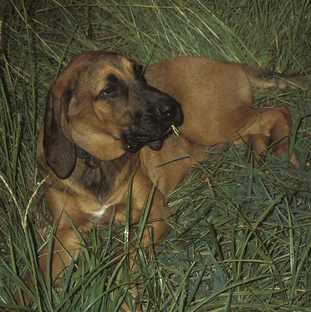
Figure 9-10 A combination lying posture of sternal recumbency in front and lateral recumbency behind.
The Beagle study at Texas A&M University showed that the run-housed dog averaged 1 hour a day sitting and 16.6 hours lying in one of the various positions (see Table 9-2). Other researchers have noticed a difference in the percent of time spent sitting or lying based on cage size. Beagles kept in standard cages spend 12.7% of their day sitting and 6.6% of their time lying. Those in large cages sit 9.4% of the time and lie down 8.3% of the day.82
Where a dog rests varies with individuals. Many house dogs will lie near an owner, or they have favorite spots if the owner is not home. This preferred location could be on a tile floor for coolness or on a sofa or owner’s bed. Some outdoor dogs like to rest on top of their doghouse roof, perhaps to be able to keep an eye on neighborhood activities. Kennelled dogs and some house pets prefer a nest box sleeping environment. A relatively confined space with soft bedding that can be washed is ideal. There is also some evidence to suggest that provision of such a sleeping arrangement in each kennel will reduce the overall noise in a kennel.30
Young puppies sleep in a heap during their first few weeks of life (Fig. 9-12). As they begin developing thermoregulation at around 3 weeks of age, the puppies gradually begin to lie parallel to each other (Fig. 9-13).65 When the individual can maintain its own body temperature, it becomes more likely to sleep alone or with just one or two littermates.
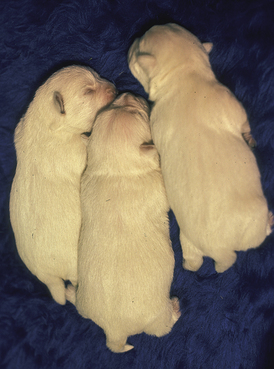
Figure 9-13 Warm puppies and those that have some ability to conserve body heat tend to lie parallel.
During puppyhood, changes in sleep patterns occur, documented both by electroencephalograms (EEGs) and behavioral observations. At birth, puppies tend to abruptly alternate between wakefulness and activated sleep, such that the EEGs show little change.61,64 At 2 weeks, slow-wave sleep patterns first appear on the EEG.64 The amount of wakefulness increases, and activated sleep decreases so that by 3 weeks, they are about equal.64 At this time, it is uncommon for the puppy to go directly from wakefulness to activated sleep.61,62 By 4.5 weeks, the puppies are alert more than 50% of the time, and the amount of quiet sleep becomes greater than that of activated sleep.64 Activated sleep has decreased significantly in 5-week-old puppies.64 By 8 weeks, differences between sleep and wakefulness are adult-like.55
Sleep patterns in adult dogs will vary somewhat because of light/dark cycles, surrounding activities, and familiarity of surroundings. In 12-hour light/dark cycles, laboratory dogs have one peak sleep period from 2100 to 0400 hours, and many also show a tendency to sleep from 1300 to 0500.4,77,104 The adult dog goes from wakefulness, to drowsiness, to slow-wave sleep, to REM (rapid eye movement or active) sleep, and then back to slow-wave sleep again or to arousal. Alertness gradually decreases for the first hour after the lights go out, and a gradual increase begins approximately 1 hour before the lights come on again.
In slow-wave sleep, the animal will lie down or crouch, close its eyes, and breathe regularly. Although it may shift positions occasionally, the dog is relatively unresponsive to the environment.76
In REM sleep, the EEG is almost the same as when the dog is awake, but there is a motor paralysis of the skeletal muscles.77 Complete relaxation of the neck and back muscles results from active inhibition of spinal motor neurons, possibly by activation of acetylcholine-containing neurons in the causal brainstem, releasing a chain of events that results in the postsynaptic inhibition.111 Respiration is irregular. Phasic movements of the distal digital, facial, extraocular, and tail muscles occur.76,77 Dogs appear to paddle with all four limbs, and they may vocalize, as air is irregularly forced through the larynx.76,77 In humans, dreaming occurs during REM sleep.4,133 Because dogs also have REM sleep, it is possible that they might be able to dream, but this theory is impossible to prove.77,133 Although a new habitat will suppress REM sleep for a night, the deficit will be made up during the next 2 nights.5
Dogs average 23 sleep-wake episodes per hour during an 8-hour period.5,6,7 Each episode consists of a sleep period of 5 to 16 minutes followed by a 5-minute awake period. Active sleep, presumed to be REM sleep, occurs in 0.2 to 1.0 sessions per hour, each lasting 2.1 to 9.7 minutes.7 These sessions are followed by either more slow-wave sleep or spontaneous arousal.5 Dogs in REM sleep can be aroused almost instantly by external stimuli.76 In 24 hours, the average dog spends 9.7 hours in quiet sleep (3.6 to 5.9 hours in light, slow-wave sleep; 4.6 to 7.0 hours in deep, slow-wave sleep) and between 2.3 and 3.3 hours in active, REM sleep.146
The active sleep-quiet sleep cycle takes 20 minutes in dogs versus 90 minutes in humans.50,77,104 The average sleep-wake cycle is 79 to 83 minutes, with 39 to 45 minutes of sleep episodes, 38 to 40 minutes of a mean wake period, and two REM episodes per sleep-wake cycle.4,104,121 A normal pet dog spends 44% to 48% of its time awake, 19% to 21% drowsy, 22% to 23% in slow-wave sleep, and 9% to 12% in REM sleep.40,103,104,121 These sleep patterns can be affected by drugs in dogs just as in humans.145
Components of REM are initiated by catecholamine mechanisms in the lateral pontine reticular area.133 The muscular atonia is associated with that area’s locus coeruleus.133 The movements that are so characteristic of REM sleep occur as the result of monophasic spike clusters originating in the pons.133 People are more easily aroused from REM sleep than from slow-wave sleep, and it is generally believed that this is true for animals as well.6
One trait that dog owners appreciate is being warned about potential danger, so they would like the dog to be responsive to appropriate stimuli at all times. Tests of a dog’s responsiveness to auditory stimuli show a weak startle response during sleep beginning at about 18 days of age in puppies.59 As might be expected, a dog is significantly more responsive when it is awake than when it is asleep,6 and there is no difference in responsiveness to auditory stimuli during slow-wave sleep versus REM sleep.6 Dogs bark at 29% of the auditory stimuli, and they are more likely to bark or be alert to a barking sound than to any other stimuli.6 In groups of dogs, one individual is usually more likely to bark than the others, and barking in response to a stimulus is more apt to occur when dogs are kept in a group than when they are kept alone.6
